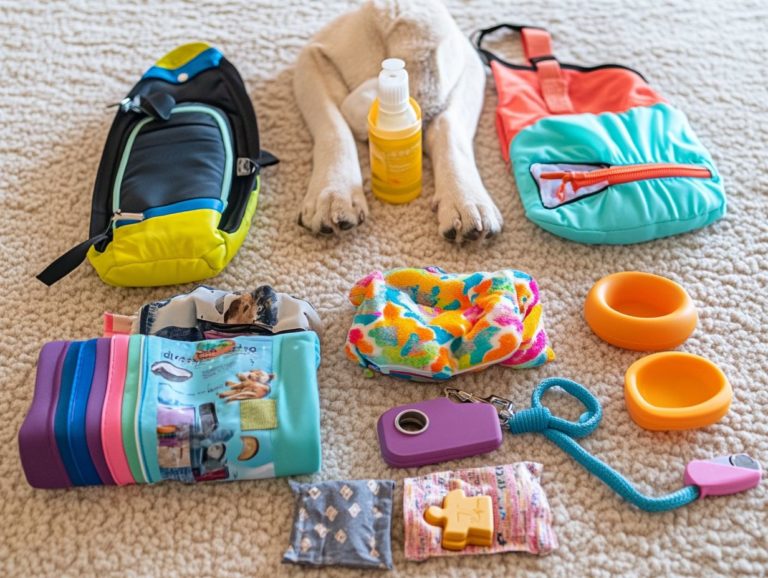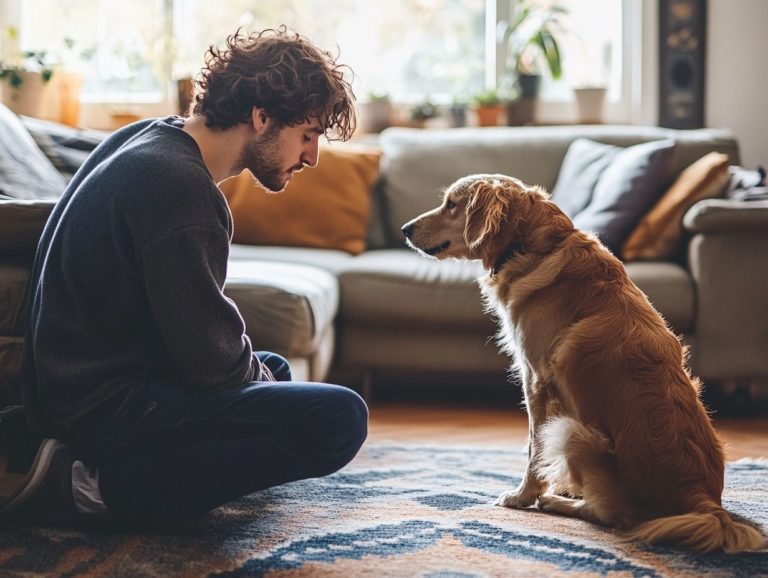How to Use Body Language in Pet Training
When it comes to training your pet, effective communication is paramount!
While verbal commands hold their importance, body language often plays a crucial role that tends to be overlooked. By understanding both your pet’s and your own nonverbal cues, you can significantly elevate the training process.
This article delves into why body language matters, how to interpret common behaviors, and techniques for communicating more effectively with your furry companion!
Whether you’re teaching new commands or addressing behavioral issues, mastering the art of body language can lead to a more successful and rewarding training experience for both you and your pet!
Contents
- Key Takeaways:
- The Importance of Body Language in Pet Training
- Understanding Your Pet’s Body Language
- Using Body Language to Communicate with Your Pet
- Body Language Techniques for Specific Training Goals
- Body Language Do’s and Don’ts in Pet Training
- Incorporating Body Language into Your Training Routine
- Frequently Asked Questions
- What is body language and why is it important in pet training?
- How can I use body language to command my pet?
- Are there specific body language cues that my pet will understand?
- Can I use body language to correct unwanted behaviors in my pet?
- How can I tell if my pet understands my body language?
- Can I use body language to strengthen my bond with my pet?
Key Takeaways:
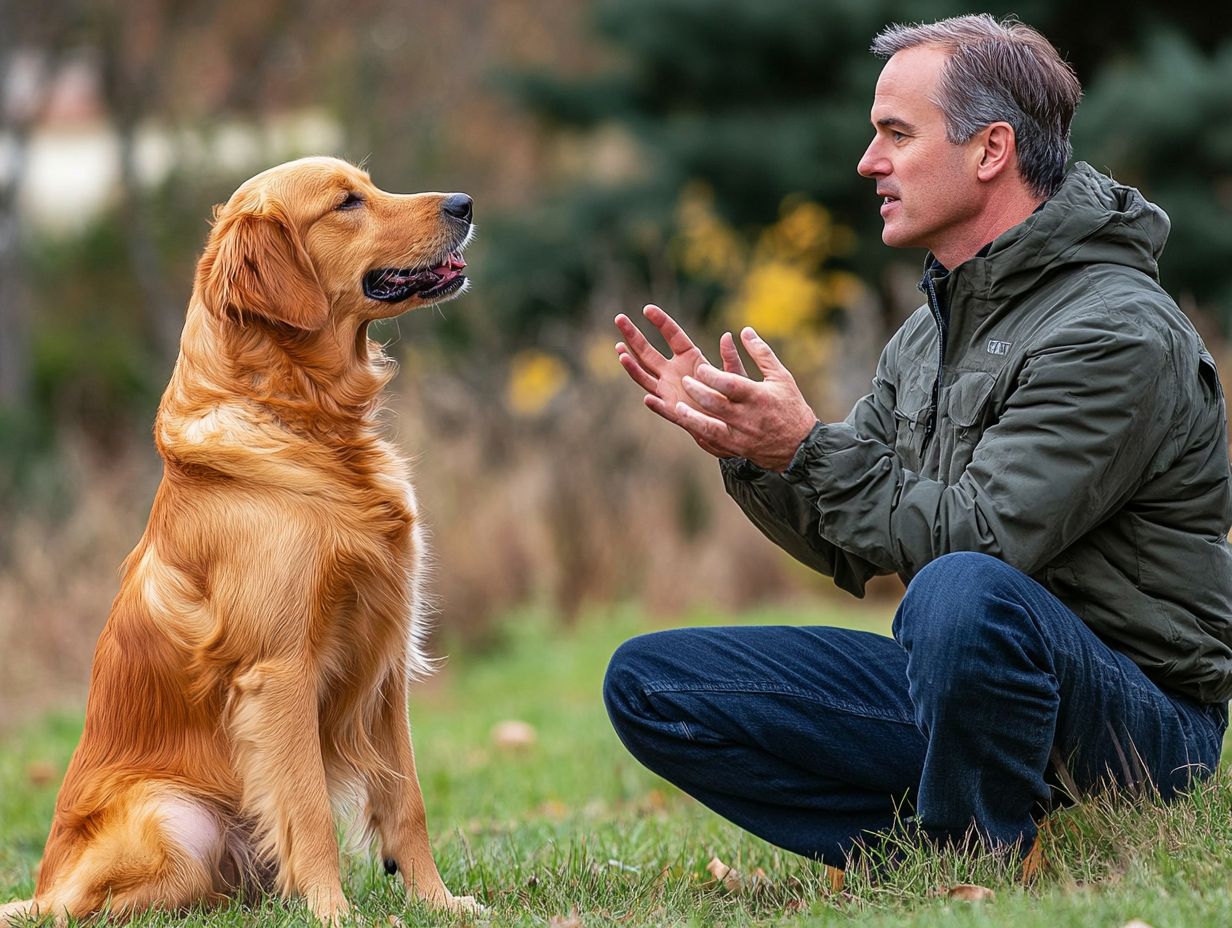
- Body language is a crucial part of pet training as it allows for effective communication and understanding between you and your pet.
- By interpreting common behaviors and using positive reinforcement, you can effectively communicate with your pet and achieve specific training goals.
- Consistency and avoiding common pitfalls are key to successfully incorporating body language into your pet training routine.
The Importance of Body Language in Pet Training
Understanding the significance of body language in pet training is essential for cultivating a strong bond with your dog. It enables you to interpret their emotions and intentions more effectively.
Body language acts as a silent communication tool, allowing you to grasp what your canine companion is really trying to express. This enhances trust and deepens your connection. By paying attention to signals like tail-wagging, raised hackles, and various facial expressions, you can respond appropriately!
Experts such as Turid Rugaas and renowned institutions like the K9 Training Institute emphasize the importance of mastering these cues for effective training and a better bond with your pet.
Why Body Language Matters
Body language is crucial in dog training because it enables you to accurately interpret your dog’s emotions and intentions, fostering effective communication.
For instance, when your dog’s fur stands on end, it signals heightened alertness or anxiety, indicating that your dog may feel threatened or scared. Conversely, if you notice your dog licking its lips, it s likely feeling stress or uncertainty, especially in new situations.
When your dog performs a play bow front end lowered, back end raised it s a clear sign of relaxation and an invitation to engage! Recognizing these signals strengthens the bond between you and your dog and customizes your training methods.
If your dog shows signs of stress, a gentler approach is essential to ensure their safety and comfort. Relaxed body language opens the door for playful and effective training sessions!
Understanding Your Pet’s Body Language
To truly grasp your pet’s body language, it s vital for you to observe the myriad signals and cues that unveil their emotions and state of mind. This keen awareness will deepen your understanding and elevate the quality of communication you share with them!
Interpreting Common Behaviors
Interpreting common behaviors in dogs, such as barking and growling, is essential for grasping their body language and emotional states.
By closely observing a dog s posture, tail position, and facial expressions, you can uncover valuable insights into how the animal feels in various situations. For example, a tail wagging high might indicate excitement and happiness, while a lowered tail could suggest submission or fear. Behaviors like cowering or turning away can signal stress or defensiveness, especially when a dog feels threatened by its surroundings or other animals.
Understanding these signals strengthens the bond between you and your pet and ensures safer interactions with unfamiliar dogs. Remember, context plays a crucial role in interpreting these signals, so staying attuned to your dog s communication is key!
Take action today! Observe your pet’s body language and start implementing these techniques for a stronger bond and effective training experience!
Using Body Language to Communicate with Your Pet
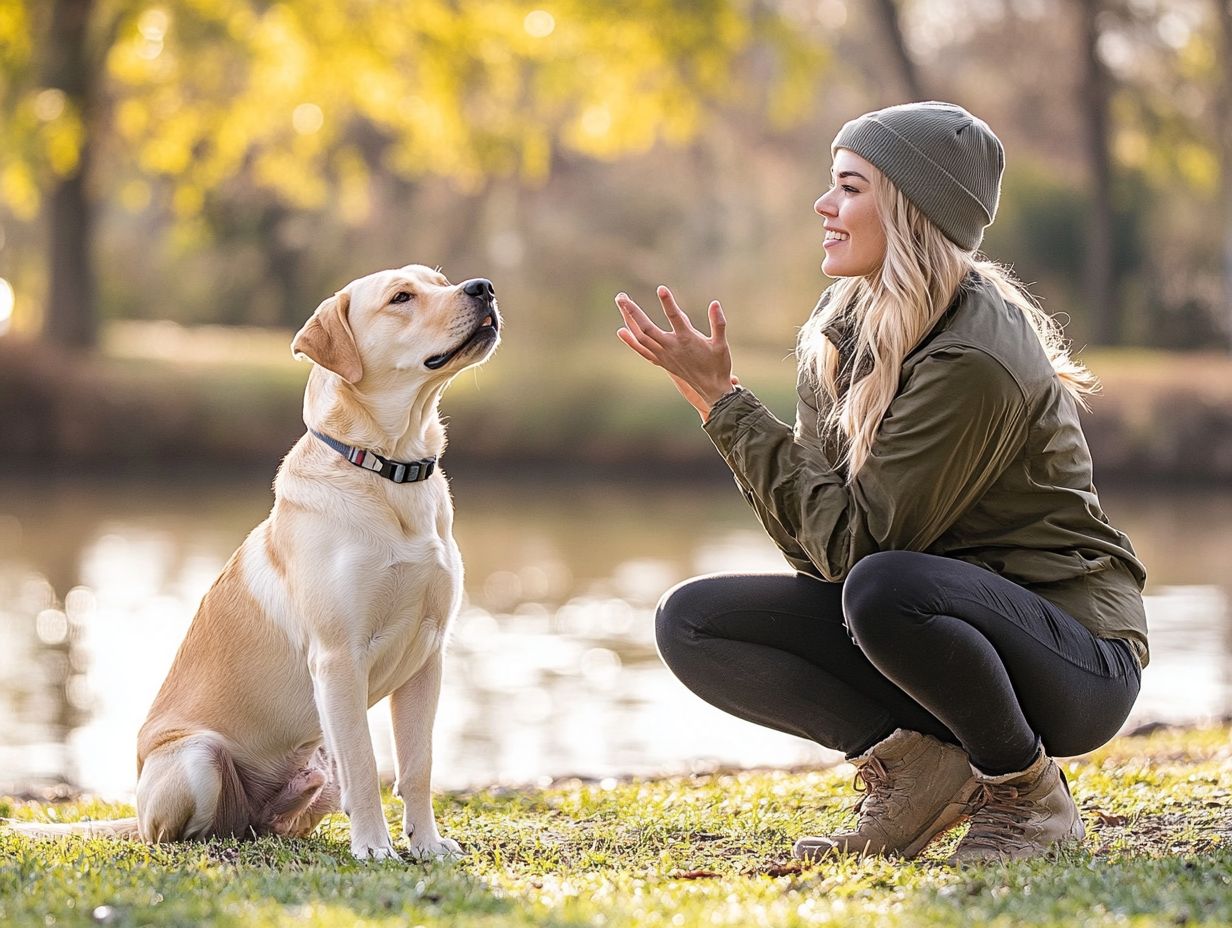
Utilizing body language to communicate with your dog is a very useful skill that can enhance your training efforts and strengthen your connection. This method makes your interactions more exciting and effective!
Positive Reinforcement and Nonverbal Cues
Combining rewarding good behavior with nonverbal cues creates an exceptional training atmosphere that inspires desired behaviors in dogs.
This powerful combination enhances your dog’s learning experience by ensuring clear and consistent communication. Dogs are naturally tuned to body language, so using gestures like pointing or nodding effectively reinforces your commands.
Maintain eye contact or give a thumbs-up when your dog accomplishes a desired action; this further solidifies their understanding. Incorporate treats or praise right after a successful response to strengthen the behavior, increasing the likelihood of repetition.
By embracing this holistic approach, you cultivate a deeper bond with your dog and make the training process more enjoyable and effective for both of you.
Body Language Techniques for Specific Training Goals
By using body language techniques tailored for your training goals, you can significantly improve your dog’s learning experience, making commands more intuitive and easier for them to grasp.
Teaching Commands
Teaching commands to your dog becomes much more effective when you use body language techniques that provide clear, visual signals. By integrating these nonverbal cues, you create a more intuitive learning environment for your furry friend.
For example, to teach the sit command, lower your body to your dog’s level and gently move your hand from above their head to the back. This gesture signals that it s time to sit. Likewise, when you want your dog to come, an open palm with a slight forward lean invites them toward you, conveying excitement.
These gestures enhance your dog s understanding and strengthen the bond between you both.
Addressing Problem Behaviors
Addressing problem behaviors in dogs requires a keen understanding of body language and effective communication strategies to inspire positive changes.
Recognizing subtle cues, such as tail position or ear orientation (how a dog’s ears position can reflect their feelings), provides valuable insights into your dog s emotional state.
For instance, a wagging tail might look friendly, but if paired with raised hackles, it could indicate anxiety or aggression. By interpreting these signals, you can identify underlying issues like fear, frustration, or boredom, which often show up as behaviors like excessive barking or destructive chewing.
Implement consistent training techniques and reward desired behaviors to create a trusting environment for your dog. Patience is vital; behavior modification is a gradual journey requiring regular reinforcement and a positive mindset for lasting results.
Body Language Do’s and Don’ts in Pet Training
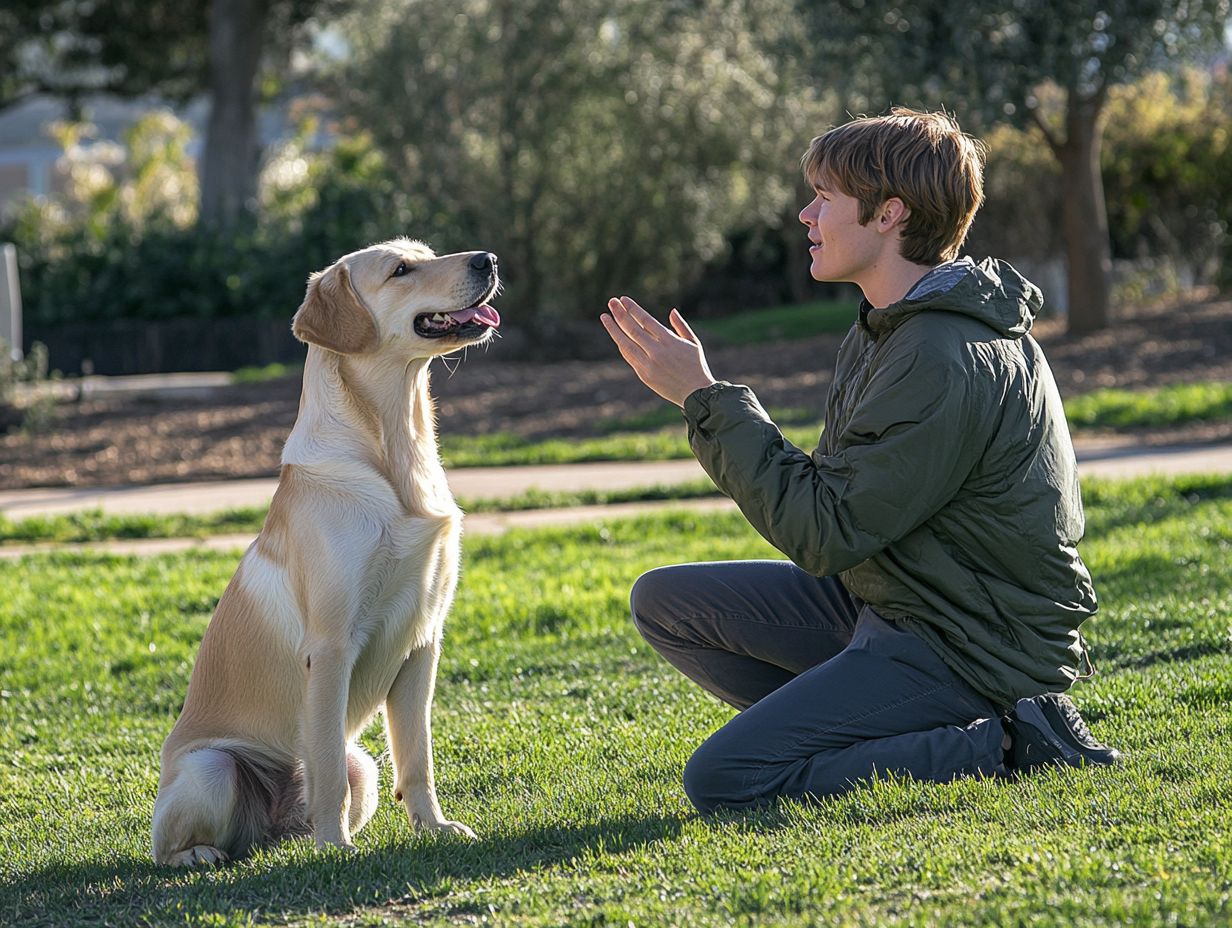
Understanding the nuances of body language in pet training is crucial for effective communication and cultivating a positive training atmosphere for your dog.
By recognizing the do’s and don’ts, you can enhance your training experience and build a stronger bond with your furry companion.
Start using body language in your training today!
Effective Techniques and Pitfalls to Avoid
Implementing effective techniques while being mindful of potential pitfalls is essential for your success in dog training and communication.
Using methods like positive reinforcement, where you reward desirable behaviors, builds a trusting relationship with your dog. This approach encourages your canine companion to repeat good behaviors and turns training into a collaborative and enjoyable experience.
Clear signals from your body are vital for sending messages without confusion. Unclear cues or inconsistent behavior can lead to misunderstandings, causing frustration for both of you.
Pay attention to these interactions. Avoid common training mistakes to help your dog learn better. This is crucial for nurturing a well-behaved and happy canine companion.
Incorporating Body Language into Your Training Routine
Using body language in your training routine is essential for achieving consistency and cultivating a successful bond with your dog. This boosts your training success and strengthens your bond with your furry friend!
Tips for Consistency and Success
Consistency in applying signals from your body during training sessions is crucial for your dog’s learning journey.
Create a daily routine that includes practice sessions. This helps both you and your dog become familiar with these signals over time.
Observing other trainers and their interactions with dogs can offer valuable insights into effective body language. Using video recordings of your training sessions can help you find areas for improvement.
Reinforce learned behaviors through positive reinforcement and regularly reassess your techniques. This strengthens the connection between cues and responses, making communication smoother and more intuitive.
Frequently Asked Questions
What is body language and why is it important in pet training?
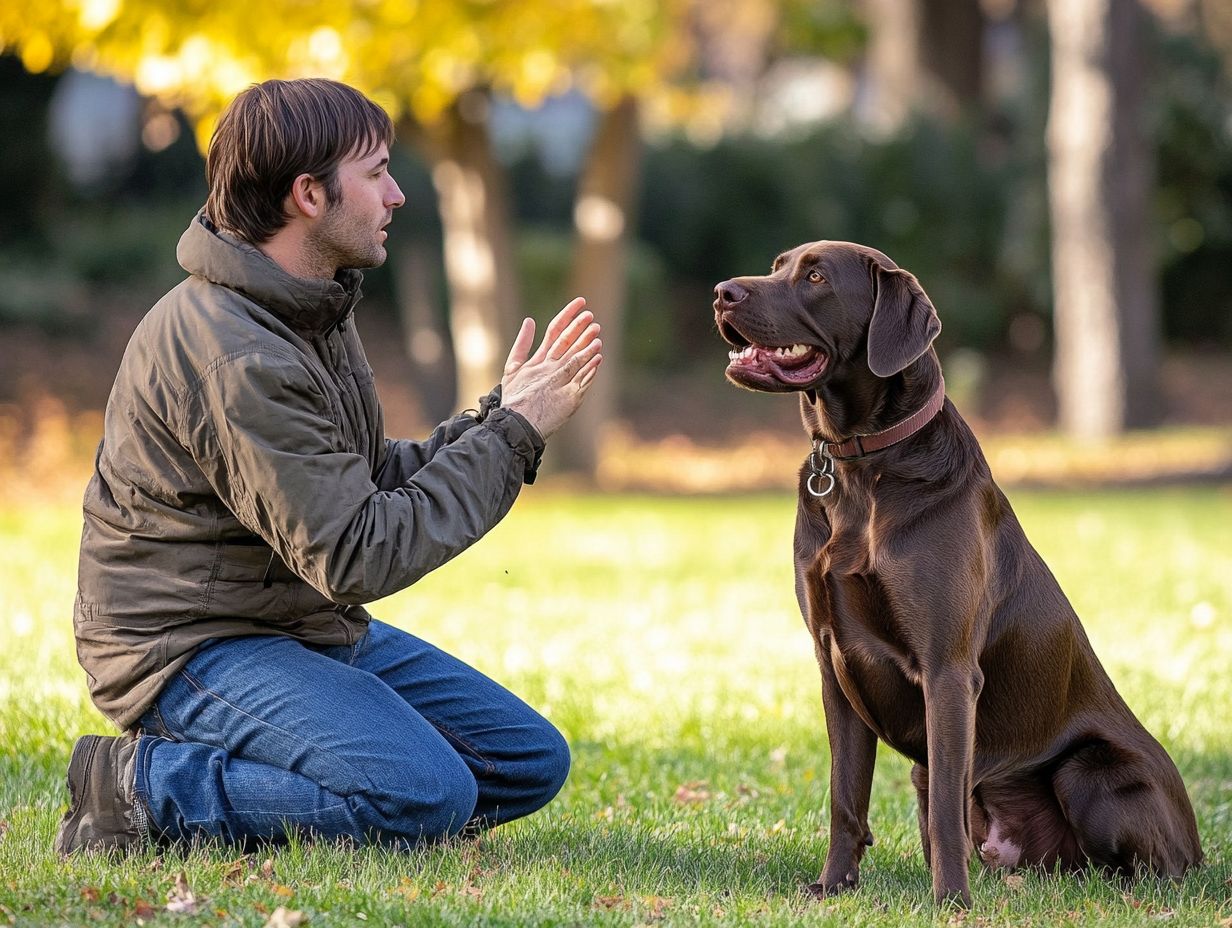
Body language is a form of nonverbal communication that includes gestures, postures, and facial expressions. It allows you to communicate with your pet in a way they understand, strengthening your bond and improving training outcomes. Emotions such as nervousness, stress, and intentions can also be conveyed through body language.
How can I use body language to command my pet?
Start by using clear and consistent signals, such as hand gestures or body postures, to give commands. Always be aware of your body language and ensure it matches the command you are giving. For example, standing tall and facing your pet can signal dominance, while crouching down can signal playfulness.
Are there specific body language cues that my pet will understand?
Yes, there are universal cues for most animals. A calm, relaxed posture with a soft gaze signals that everything is okay and they can trust you. Conversely, a tense posture with a direct stare can signal danger or aggression.
Can I use body language to correct unwanted behaviors in my pet?
Yes, you can use body language to redirect or correct unwanted behaviors. For example, turning your body away from your pet can indicate disapproval, while ignoring them communicates that their behavior is not getting your attention. Be sure to also use positive reinforcement when your pet displays desired behaviors.
How can I tell if my pet understands my body language?
Pay attention to how your pet reacts to your body language. If they follow your instructions or respond positively, they are likely understanding you well.
If not, try using different signals or consult a trainer who specializes in teaching pets.
Can I use body language to strengthen my bond with my pet?
You can use body language to create a stronger bond with your pet. By being consistent and positive, you ll show them you re a trustworthy leader.
Don t forget to offer plenty of hugs and verbal praise to reinforce this connection!

